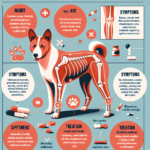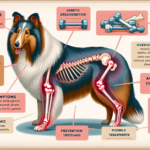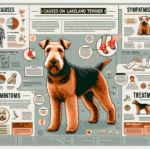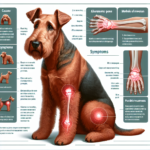Vizsla Joint Pain: Causes, Symptoms, Prevention, and Treatment
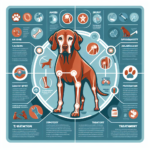
Introduction
The Vizsla, often referred to as the Hungarian Pointer, is a versatile and energetic breed known for its hunting prowess and affectionate nature. Originating from Hungary, the Vizsla has a rich history dating back to the 10th century, where it was bred by the Magyar tribes for hunting and retrieving game. Characterized by its sleek, golden-rust coat, muscular build, and expressive eyes, the Vizsla is not only a skilled hunter but also a loyal family companion.
While Vizslas are generally healthy dogs, they are prone to certain health issues, including joint pain. Joint health is particularly crucial for this breed due to their high activity levels and athletic nature. Ensuring the well-being of their joints can significantly enhance their quality of life and longevity.
Breed-Specific Joint Pain Risks
Genetic Predisposition
Vizslas, like many other breeds, have a genetic predisposition to joint-related issues. Hip dysplasia, a condition where the hip joint doesn’t fit properly into the hip socket, is relatively common in Vizslas. This can lead to arthritis and significant discomfort over time. Elbow dysplasia, another hereditary condition, affects the elbow joints and can cause lameness and pain.
Age-Related Risks
As Vizslas age, the risk of developing joint pain increases. Typically, signs of joint issues may start to appear in middle age, around 5 to 7 years old. However, some dogs may show symptoms earlier, especially if they have a genetic predisposition or have experienced joint injuries.
Activity Level and Joint Stress
Vizslas are known for their high energy levels and need for regular exercise. While their active lifestyle is beneficial for overall health, it can also contribute to joint stress. Activities such as running, jumping, and hunting can put significant strain on their joints, potentially leading to wear and tear over time.
Common Symptoms of Joint Pain in Vizslas
General Symptoms
- Limping or favoring one leg
- Stiffness, especially after rest
- Reluctance to jump, run, or climb stairs
- Decreased activity or playfulness
- Swelling around the joints
- Whining or showing signs of discomfort when touched
Breed-Specific Symptoms
In Vizslas, joint pain may manifest as a reluctance to engage in activities they once enjoyed, such as hunting or playing fetch. They may also show a noticeable decrease in their usual exuberance and energy levels.
When to Consult a Vet
If you notice any of the above symptoms in your Vizsla, it’s essential to consult a veterinarian. Early diagnosis and intervention can prevent further deterioration and improve your dog’s quality of life. Persistent limping, significant changes in behavior, or visible swelling around the joints should prompt an immediate veterinary visit.
Preventive Measures for Joint Health
Exercise Recommendations
Regular, moderate exercise is crucial for maintaining joint health in Vizslas. Activities such as swimming, which is low-impact, can be particularly beneficial. Avoid high-impact exercises like excessive running on hard surfaces or jumping, which can strain the joints. Instead, opt for controlled activities that keep your Vizsla active without overloading their joints.
Dietary Suggestions
A balanced diet rich in essential nutrients can support joint health. Consider incorporating foods or supplements that contain glucosamine, chondroitin, and omega-3 fatty acids, which are known to promote joint health. High-quality commercial dog foods often include these nutrients, but consult your vet for personalized dietary recommendations.
Weight Management
Maintaining a healthy weight is vital for reducing joint stress. Overweight dogs are at a higher risk of developing joint issues due to the extra load on their joints. Regularly monitor your Vizsla’s weight and adjust their diet and exercise routine as needed to keep them within a healthy weight range.
Early Screening and Monitoring
Regular veterinary check-ups are essential for early detection of joint issues. Screening tests such as X-rays can help identify problems like hip or elbow dysplasia before they become severe. Early intervention can significantly improve outcomes and slow the progression of joint diseases.
Treatment Options for Joint Pain
Non-Surgical Treatments
Non-surgical treatments for joint pain in Vizslas include medications such as non-steroidal anti-inflammatory drugs (NSAIDs) to reduce pain and inflammation. Physical therapy can also be beneficial, helping to strengthen the muscles around the joints and improve mobility. Lifestyle adjustments, such as providing a comfortable resting area and avoiding strenuous activities, can also help manage pain.
Surgical Options
In severe cases, surgical intervention may be necessary. Common surgeries for joint issues in Vizslas include hip replacement, arthroscopy to remove bone fragments, and corrective surgeries for elbow dysplasia. These procedures can significantly improve mobility and reduce pain, but they come with risks and require a thorough discussion with your veterinarian.
Alternative Therapies
Alternative treatments such as acupuncture, hydrotherapy, and massage can provide additional relief for joint pain. Acupuncture can help reduce pain and inflammation, while hydrotherapy offers low-impact exercise that strengthens muscles without stressing the joints. Massage therapy can improve circulation and reduce muscle tension, providing comfort to your Vizsla.
Lifestyle and Management Tips
Daily Care Routine
A daily care routine for a Vizsla with joint pain should include gentle exercise, a balanced diet, and regular rest periods. Short, frequent walks can help maintain mobility without overloading the joints. Ensure your dog has a comfortable, supportive bed to rest on, and avoid activities that involve jumping or sudden movements.
Modifying the Home Environment
Making your home more joint-friendly can significantly improve your Vizsla’s comfort. Consider installing ramps to help them navigate stairs or get onto furniture. Orthopedic beds provide better support for aching joints, and non-slip mats can prevent falls on slippery surfaces.
Long-Term Management
Long-term management of joint pain involves regular veterinary check-ups, consistent weight management, and ongoing physical therapy or alternative treatments. Keeping your Vizsla active and engaged with low-impact activities can help maintain their quality of life. Monitoring their condition and adjusting their care routine as needed will ensure they remain happy and comfortable.
FAQs About Vizslas and Joint Pain
What are the early signs of joint pain in Vizslas?
Early signs of joint pain in Vizslas include limping, stiffness, reluctance to jump or climb stairs, and decreased activity levels. If you notice these symptoms, consult your veterinarian for a thorough examination.
Can joint pain in Vizslas be prevented?
While genetic predispositions cannot be entirely prevented, maintaining a healthy weight, providing a balanced diet, and ensuring regular, moderate exercise can significantly reduce the risk of joint pain. Early screening and monitoring can also help catch issues before they become severe.
Are there specific foods that can help with joint health in Vizslas?
Yes, foods rich in glucosamine, chondroitin, and omega-3 fatty acids can support joint health. High-quality commercial dog foods often include these nutrients, but you can also consider supplements after consulting with your veterinarian.
When should I consider surgery for my Vizsla’s joint pain?
Surgery should be considered when non-surgical treatments no longer provide relief, and your Vizsla’s quality of life is significantly affected. Discuss the potential benefits and risks with your veterinarian to make an informed decision.
What alternative therapies are effective for joint pain in Vizslas?
Alternative therapies such as acupuncture, hydrotherapy, and massage can be effective in managing joint pain. These treatments can reduce pain, improve mobility, and enhance overall well-being. Consult your veterinarian to determine the best options for your dog.
Conclusion
Joint pain is a common concern for Vizslas, but with proper care and preventive measures, you can significantly improve your dog’s quality of life. Regular exercise, a balanced diet, weight management, and early screening are essential for maintaining joint health. If joint pain does develop, a combination of non-surgical treatments, surgical options, and alternative therapies can provide relief. By staying vigilant and consulting your veterinarian regularly, you can ensure your Vizsla remains active, happy, and comfortable throughout their life.

